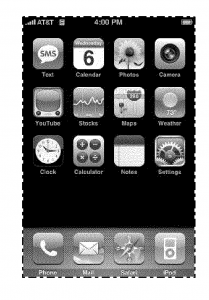 In a 2016 decision in Samsung v. Apple, the Supreme Court determined that the relevant “article of manufacture” for calculating total profits damages for design patent infringement could be either (1) the product (e.g. the Samsung phone) sold to a customer or (2) a component of that product.
In a 2016 decision in Samsung v. Apple, the Supreme Court determined that the relevant “article of manufacture” for calculating total profits damages for design patent infringement could be either (1) the product (e.g. the Samsung phone) sold to a customer or (2) a component of that product.
Previously, the “article of manufacture” for calculating total profits damages for design patent infringement was the entire product sold to a customer. The profits to the entire product are usually likely to be greater than profits to a component of the entire product.
The case was sent back to the trial court and a new trial was ordered on damages. In October 2017, the trial court ruled that a four factor test would be used to determine what is the article of manufacture for the purposes of damages under 35 USC 289. The four factors are:
- The scope of the design claimed in the plaintiff’s patent, including the drawing and written description;
- The relative prominence of the design within the product as a whole;
- Whether the design is conceptually distinct from the product as a whole; and
- The physical relationship between the patented design and the rest of the product, including whether the design pertains to a component that a user or seller can physically separate from the product as a whole, and whether the design is embodied in a component that is manufactured separately from the rest of the product, or if the component can be sold separately.
Under this test, it is possible that a jury could conclude that the article of manufacture is the entire Samsung phone and not just a component of it. If so, the result could be largely the same as before the Supreme Court decision.
Both Apple and Samsung at certain times in the case supported the four factor test. This means that each saw or sees a way to win under the test. If a jury determines the article is the whole infringing phone, Apple is a winner. If a jury determines the article is less than the whole phone, Samsung may succeed in reducing the damages awarded.
There are three design patents at issue: D593,087 is directed to primarily the front face of the iPhone and the beveled edge, D618,677 is primarily directed to the black “infinity pool” face of the iPhone, and D604,305 is directed to the home screen user interface. Representative figures from the each patent, respectively, is shown below.



Even if Apple can’t show, with respect to each patent, that the “article” is the whole infringing phone, these three patents cover the home screen user interface and the exterior of the device, except for the back. These features are arguably a large part of the visual appeal of the device. But, these patents do not cover the side profile of the device, or as mentioned, the back. We will see how close Apple gets to the original damage award of $399 million, which was the entire profit Samsung made from its sale of the infringing smartphones.
Citation: Apple Inc. v. Samsung Electronics Co., no. 11-CV-01846, 2017 U.S. Dist. LEXIS 177199; 2017 WL 4776443 (N.D.Cal. Oct. 22, 2017).
One Reply to “Four Factor Test for Determining the Article for Total Profit Damages in Apple v. Samsung”
Comments are closed.